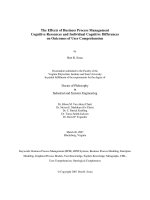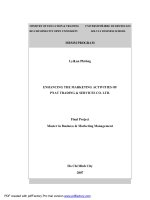Faculty Of Business Digital Marketing Services Marketing Managerment Individual Report.pdf
Bạn đang xem bản rút gọn của tài liệu. Xem và tải ngay bản đầy đủ của tài liệu tại đây (1.9 MB, 12 trang )
<span class="text_page_counter">Trang 1</span><div class="page_container" data-page="1">
<b>FACULTY OF BUSINESSDIGITAL MARKETING</b>
<b>SERVICES MARKETING MANAGERMENT</b>
<b>INDIVIDUAL REPORT</b>
Student’s InformationName: Vũ Văn Tuyền Roll
number:
HS171566 Course: MKT202 Class: MKT1709
Lecturer: Phạm Khánh HuyềnSubmission date:18/06/2023
</div><span class="text_page_counter">Trang 2</span><div class="page_container" data-page="2"><b>Table of Contents </b>
Question 1: Describe an unsatisfactory encounter you recently experienced with (a) a low-contact service provider via email, mail, or phone and (b) a high-contact, face- -toface service provider. What were the key drivers of your dissatisfaction with these encounters? In each instance, what could the service provider have done to improve the service? ... 3 Question 2: Select one high-contact and one low-contact service. Using the Flower of Service framework presented in Chapter 4, define the core product and then identify and categorize all the supplementary elements for each of the two services. Describe the results of your analysis. Discuss how the petals can be used for service
differentiation and competitive advantage. ... 5 Question 3: Analyze a successful advertising campaign for a service. Why do you consider the campaign a success? What elements contributed to the campaign’s success? ... 9
<b>References</b> ... 12
</div><span class="text_page_counter">Trang 3</span><div class="page_container" data-page="3"><b>a low-contact service provider via email, mail, or phone and (b) a high-contact, to-face service provider. What were the key drivers of your dissatisfaction with these encounters? In each instance, what could the service provider have done to improve the service? </b>
<b>face-Unsatisfied encounter with Low Contact Service Provider (Phone): </b>
I recently had a very unpleasant encounter with a low-contact service provider over the phone. I
called customer support to resolve my internet connection problem. Since the moment I called,
my emotions have dropped.
First, voice autopilot is too complex and difficult to navigate. It took a few minutes of listening
to the array of options before I could get to the right department. That took up my time.
Next, when I was connected to a customer service representative, the frustration continued. They
don't seem to care about my problem. They spoke in a monotone and seemed to be reading the
script without taking the time to understand my particular problem. Their lack of empathy and
engagement only further frustrates me.
Furthermore, the representative provided vague and generic troubleshooting steps that I tried
before calling. They don't seem prepared to handle more complex issues and don't offer any
alternatives or escalation options. It felt like they were simply letting it go without really trying
to solve my problem.
To improve the service, the telecom company may have made some changes. First, simplifying
</div><span class="text_page_counter">Trang 4</span><div class="page_container" data-page="4">representatives on how to actively listen, solve problems, and communicate empathically will
greatly enhance the quality of interactions. Finally, having a system in place to route calls to a
higher level of support for more complex issues demonstrates a commitment to effectively
resolving customer issues.
<b>Unsatisfied meeting with face- -face service provider: to</b>
In another unsatisfactory encounter, I had a disappointing experience with a live service provider
at a local electronics store. I bought a faulty electronic device and went to the store to ask for a
replacement or refund. However, the store staff I encountered were unhelpful and uninterested in
solving my problem.
Employees have a disdainful attitude and lack of understanding about their store's return policy.
They didn't seem to want to listen to my concerns and make no effort to come up with a
satisfactory solution. The lack of empathy and customer-oriented approach made me feel ignored
and underappreciated as a customer.
In this case, the service provider could have improved service by ensuring that all employees
were thoroughly trained in the store's policies and procedures. Empowering staff to make
decisions regarding refunds or replacements within reasonable limits will also greatly help in
resolving customer issues in a timely manner. Furthermore, instilling a customer-centric culture
and providing ongoing training in effective problem-solving and communication skills will help
</div><span class="text_page_counter">Trang 5</span><div class="page_container" data-page="5"><b>Question 2: Select one high-contact and one low-contact service. Using the Flower of Service framework presented in Chapter 4, define the core product and then identify and categorize all the supplementary elements for each of the two services. Describe the results of your analysis. Discuss how the petals can be used for service differentiation and competitive advantage. </b>
<b>High-Contact Service: Restaurant Dining </b>
Core Product: The core product in restaurant dining is the provision of food and beverages to
customers in a comfortable and enjoyable dining environment.
</div><span class="text_page_counter">Trang 6</span><div class="page_container" data-page="6">1. Order-Taking: Servers take orders promptly and accurately, ensuring that customers'
preferences and special requests are noted and communicated to the kitchen staff.
2. Hospitality: Restaurant staff greet and welcome guests, creating a warm and inviting
atmosphere. They provide attentive service, ensuring that customers feel valued and well taken
care of throughout their dining experience.
3. Safekeeping: Restaurants offer secure coat-check services or storage options for personal
belongings, ensuring the safety of customers' possessions during their visit.
4. Exceptions: Restaurants accommodate special requests, such as modifications to dishes for
dietary restrictions or preferences, ensuring that customers' individual needs are met.
5. Billing: The restaurant provides accurate and itemized bills, making it easy for customers to
understand and settle their payments.
6. Payment: Convenient and secure payment options are offered, including cash, credit cards,
and mobile payment apps, giving customers flexibility and ease of transaction.
7. Information: Menus, signage, and staff provide information about the ingredients used, food
preparation methods, sourcing practices, and any allergens present in the dishes, catering to
customers' need for transparency and dietary awareness.
8. Consultation: Knowledgeable staff offer recommendations, describe menu items, and provide
guidance on pairings or dietary restrictions, enhancing the overall dining experience.
</div><span class="text_page_counter">Trang 7</span><div class="page_container" data-page="7">Core Product: The core product of a ride-hailing service is the convenient and efficient
transportation provided to passengers through a mobile app.
Supplementary Elements (Petals of the Flower of Service):
1. Order-Taking: Passengers can easily request a ride through the app, input their pickup and
drop-off locations, and select any additional options or services, streamlining the booking
process.
2. Hospitality: Though limited in physical interaction, ride-hailing apps strive to provide a
hospitable experience by offering user-friendly interfaces, clear communication, and driver
ratings/reviews.
3. Safekeeping: Ride-hailing services prioritize passenger safety by implementing safety features
like driver background checks, GPS tracking, and sharing trip details with trusted contacts.
4. Exceptions: Ride-hailing companies have dedicated customer support channels to handle
exceptional situations, such as lost items, driver behavior issues, or trip disputes, providing
prompt resolution and assistance.
5. Billing: Transparent fare breakdowns are provided at the end of each trip, detailing the
distance traveled, any additional charges, and applicable discounts or promotions, ensuring
transparency in billing.
6. Payment: Cashless transactions are facilitated through the app, ensuring a seamless and secure
payment experience for passengers. Various payment methods, such as credit cards or digital
wallets, are accepted.
7. Information: Ride-hailing apps provide detailed information about available vehicles,
</div><span class="text_page_counter">Trang 8</span><div class="page_container" data-page="8">concerns they may have, enhancing the overall customer experience.
<b>Analyze the results: </b>
In my opinion, both high-contact and low-contact services have additional elements to enhance
the customer experience. In restaurant dining, additional elements focus on hospitality, order
taking, consultation, invoicing, payment, safekeeping, information, and exceptions. These factors
contribute to a pleasant dining atmosphere, personalized service, efficient operations, transparent
payments, and responsiveness to customer preferences and needs.
As for the ride-hailing service, the additional elements revolve around information, ordering,
payment, safekeeping, exceptions, hospitality, payment and consultation. These factors focus on
providing convenience, safety, transparency, quick customer support, user-friendly interface, and
efficient problem solving.
<b>Differentiation and competitive advantage: </b>
Service providers can differentiate themselves and gain a competitive advantage by excelling in
specific complementary factors. By focusing on aspects such as personalized hospitality,
efficient order taking, transparent payments, and exceptional customer support, restaurants can
create memorable dining experiences that help them. different from competitors. Similarly,
ride-hailing companies can differentiate themselves by prioritizing passenger safety, offering
transparent and competitive pricing, and providing reliable customer service.
</div><span class="text_page_counter">Trang 9</span><div class="page_container" data-page="9"><b>Question 3: Analyze a successful advertising campaign for a service. Why do you </b>
consider the campaign a success? What elements contributed to the campaign’s
<b>success? </b>
In this question, I will analyze about Share “ a coke” of Coca-Cola
(SAGE, 2018)
A successful ad campaign that can be analyzed is Coca-Cola's "Share a Coke" campaign. This
campaign, started in 2011, involved replacing the Coca-Cola logo on bottles with popular names
and phrases, encouraging people to find and share personalized bottles with friends and family.
their bodies. Here are some reasons why this campaign can be considered successful:
The first is personalization: The campaign leverages the power of personalization by printing a
personal name on the bottle. This creates a sense of uniqueness and makes consumers feel a
personal connection to the brand. By exploiting the desire for personalization and self-expression,
Coca-Cola has successfully appealed to its target audience.
</div><span class="text_page_counter">Trang 10</span><div class="page_container" data-page="10">personalized bottles of wine on social media using the hashtag #ShareaCoke. This has created a
viral buzz and created user-generated content (UGC), increasing brand visibility, and reaching a
wider audience. The campaign capitalizes on social sharing trends and harnesses the power of
word-of-mouth marketing.
The third is emotional appeal: The campaign explores the emotional side of relationships and
connections. By associating the act of sharing a can of Coke with moments of happiness,
friendship, and celebration, Coca-Cola creates an emotional connection with its audience. The
campaign evokes nostalgia and a sense of belonging, resonates with consumers and strengthens
their relationship with the brand.
The next an integrated marketing: The "Share a coke" campaign used a variety of marketing is
channels to maximize its impact. It includes TV advertising, print advertising, outdoor billboards,
social media, and experiential marketing. This integrated approach ensures that the campaign
reaches consumers through multiple touchpoints, increasing the overall effectiveness of the
campaign.
Finally, global adaptation: A key element of the campaign's success was its global adaptability.
Coca-Cola has adapted the campaign to different countries by combining popular local names
and cultural references, ensuring that the campaign resonates with a wide variety of audiences.
This localization strategy has helped establish stronger bonds with consumers worldwide and
</div><span class="text_page_counter">Trang 11</span><div class="page_container" data-page="11">Measurable results: The "Share a Coke" campaign achieved significant results in terms of brand
awareness, engagement, and sales. Coca-Cola reported a 2% increase in global sales during the
campaign period, and the campaign generated more than 500,000 photos shared on social media.
After a few years the number has grown to 6 million photos increasing by nearly 25 million
followers and 250 million bottles of Coca-Cola sold in 1 summer These measurable results prove
the success of the campaign in attracting consumer attention and drive business growth. (Bích,
</div>








